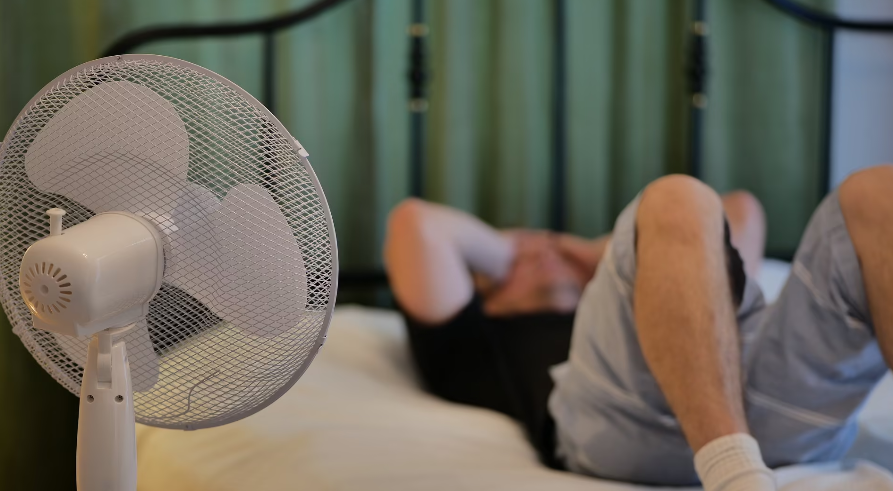Dr. Kelvas notes that when the room is too hot or cold, the body has difficulty regulating these hormones, which can lead to difficulty falling asleep or staying asleep.
The common recommendation for ambient room temperature is in the range of 60 °F (15.5 °C) to 68 °F (20 °C), according to the Sleep Foundation. It’s been found to aid the body’s thermoregulatory process to promote healthy sleep latency (the time it takes to fall asleep) and good quality sleep overall.
Temperature and the body
The human body has its thermoregulatory mechanism that allows us to maintain a healthy internal body temperature regardless of the ambient temperature of our environment. In addition, the body uses a complex interplay of physiological responses to regulate body temperature, including sweating, shivering, and changes in blood flow to the skin.
Sweating is one of the body’s primary mechanisms for cooling down. When the body’s internal temperature rises, sweat glands produce moisture that evaporates from the skin’s surface, releasing heat and hence cooling the body.
Conversely, shivering is the body’s mechanism for generating heat when the internal temperature drops. Shivering is a reflexive response that causes muscles to contract rapidly, generating heat to raise the body’s temperature.
Vasodilation, dilation, and constriction of blood vessels can also impact body temperature. For example, blood vessels near the skin’s surface dilate when the body needs to cool down, allowing more blood to flow through them. This increase in blood flow helps to release heat from the body. On the other hand, when the body needs to conserve heat, blood vessels near the skin’s surface constrict, reducing blood flow and conserving heat.
All of these mechanisms play a role as you get ready for bed and ease into the different stages of sleep. You may have experienced this shift in temperature before. For example, whenever you feel cold in bed and putting socks on makes you feel a bit warmer, that’s because a lot of heat loss occurs through our extremities — hands and feet. Thus, covering them will help make you feel warmer. Conversely, when you feel warm under the covers but don’t want to fully kick off the blanket, sticking your feet out from under the blanket may be the heat relief you need to be able to fall asleep.
Temperature and sleep
Throughout human evolution, temperature has been a strong cue for sleep and wake time. It serves as a so-called “zeitgeber” or time-giver, which is an external cue influencing our circadian rhythm. When researchers looked at sleep in three geographically distinct pre-industrial societies, they found that subjects fell asleep just as the external temperature began to drop and continued as temperatures declined. Similarly, waking up often occurred before sunrise when the ambient temperature was at its lowest and corresponded with the narrowing of blood vessels, or vasoconstriction, as indicated by the temperature of the fingers.
Thermoregulation and temperature also impact the different stages of sleep. It’s been found that about two hours prior to sleep onset, your core body temperature begins to drop and reaches its lowest point during slow-wave sleep. Additionally, the temperature in the brain also slightly decreases at this time.
Our core body temperature hovers around 98.6 °F (37 °C) but fluctuates by about two degrees Fahrenheit during the night.
Decrease in one’s core body temperature during sleep comes from reducing our metabolic output, decreased muscle tone, and decreased sympathetic tone from vasodilation leading to heat loss distally.Valerie Cacho, MD, Integrative Sleep Physician, and Women’s sleep expert
Dr. Cacho added that while melatonin is most often associated with light exposure, a cool room and the drop in body temperature can also help to increase the production of this “sleep hormone.”
If the external temperature is too warm, studies have found it to have a negative impact on both the rapid eye movement (REM) phase of sleep and slow-wave sleep (SWS). Dreams occur in the REM sleep phase, when your brain is highly active. On the other hand, SWS is associated with less brain activity but increased physiological recoveries, such as the release of human growth hormone, muscle recovery, and the flushing of toxic material, including beta-amyloid plaques, from the brain. However, both are very important for optimal physical and cognitive well-being.
When researchers looked at 10 elderly men’s responses to higher bedroom temperatures and their sleep quality, they found that even mild heat exposure during the nighttime sleep period would increase the thermal load, decrease REM, and increase wakefulness and whole-body sweat loss.
Additionally, research at the University of California, Los Angeles found that warm-blooded animals with higher body temperatures have lower amounts of REM sleep, while those with lower body temperatures have more REM sleep.
Humidity is also a contributing factor to sleep quality. One study reported that humid heat exposure increased wakefulness and decreased REM sleep and SWS. Humidity also suppressed the decrease in core body temperature.
On the contrary, when your room is too cold, Dr. Kelvas explained that the body may need to expend energy to stay warm, which can keep it from entering a deeper sleep.
Benefits of sleeping in a cold room
While it might seem subtle that room temperature would profoundly impact sleep, many people who have lived through a heat wave during summer can relate. For example, have you ever had to sleep with a cold towel on top of you or downstairs in the living room where there was more air if you didn’t have air conditioning? Or have you ever woken up groggy after getting night sweats? As women transition through menopause, hormonal changes make them even more sensitive to external temperatures. Additionally, even the body temperature of a cycling woman changes slightly throughout the month. More precisely, it’s been seen to increase during ovulation.
An optimal bedroom temperature, however, goes further than simply helping you wake up more refreshed. Here are four benefits of a cool room that will make you want to dial down your thermostat tonight.
Better sleep quality
Sleeping in a cold room helps your body release adequate amounts of melatonin and prevents cortisol (stress hormone) from rising and waking you up. Studies have shown that when you create the environment for the body to drop its core temperature throughout the night, you’ll spend more time in two of the most important restorative sleep phases: REM and slow-wave deep sleep. Additionally, you won’t have to worry about night sweats waking you up and causing sleep disturbances at night.
Fall asleep faster
Your core body temperature must drop for you to fall asleep. You will fall asleep faster when you create an environment for your body to release excess heat and support its natural circadian rhythm. A good rule of thumb to follow is if your sleep latency is between 10–20 minutes, it’s considered healthy. Insomniacs, for example, tend to experience difficulty sleeping because their bodies have a higher core temperature, which causes them to stay awake while their bodies try to cool down. This can interrupt or delay their sleep.
Better weight management
How does sleeping in a cold room help you lose weight if you’re not sweating? Cold temperatures activate the body’s “brown fat,” which is a very metabolically active tissue, also known as good fat. The more brown fat you have, the more white fat (the fat around your tummy) will burn. Researchers in Australia put men through a controlled sleep environment with different room temperatures. They found that following a month of sleeping in a cooler environment at 66 °F (18.8 °C), the volume of beneficial brown fat in the body had nearly doubled.
Lower risk of diseases
Due to the increase of brown fat, insulin sensitivity increases, which can be key to preventing type 2 diabetes and other metabolic conditions. The Australian study also found that during the time participants slept in the 66 °F (18.8 °C) room, they burned more calories during the day.
Additionally, sleeping in a cool room may help prevent Alzheimer’s disease by helping the body to tap into all the restorative stages of sleep along with acquiring the recommended seven to nine hours of slumber. A cross-sectional study published in the JAMA Neurology found that both short and long sleep durations were associated with worse outcomes for older adults, such as “greater beta-amyloid plaque burden, greater depressive symptoms, higher body mass index, and cognitive decline, emphasizing the importance of maintaining adequate sleep.”
What to do when there’s no thermostat
When you live in a home that doesn’t have heating and cooling, there are still a few tricks and habits you can incorporate into your evening routine to aid your body in dropping its internal temperature prior to sleep and keep you cool at night.
Take a warm bath or shower in the evening
While it might sound contradictory to sit in a warm bath or take a warm shower to cool down the body, it does have a premise. When researchers did a meta-analysis of 17 studies on how water-based passive body heating, shower or bath, would impact various sleep metrics, they found a positive correlation. The data they investigated included sleep onset latency, awakenings after sleep onset, total sleep time, sleep efficiency, slow-wave sleep, and subjective sleep quality.

